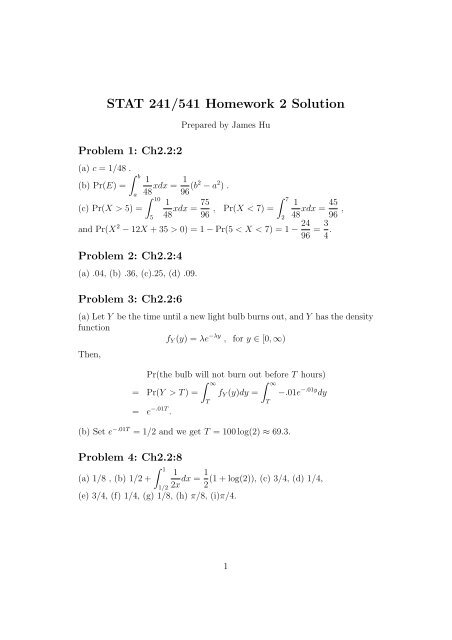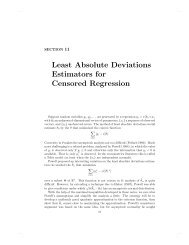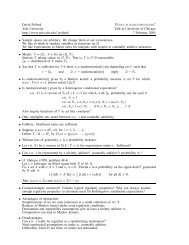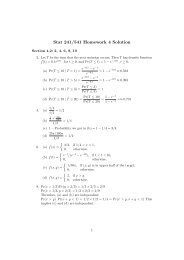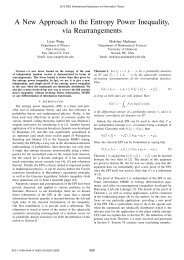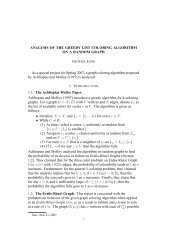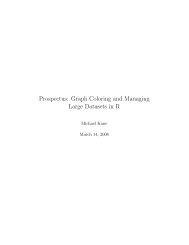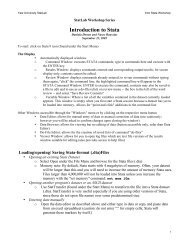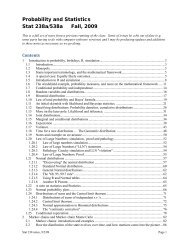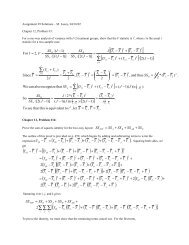STAT 241/541 Homework 2 Solution
STAT 241/541 Homework 2 Solution
STAT 241/541 Homework 2 Solution
- No tags were found...
You also want an ePaper? Increase the reach of your titles
YUMPU automatically turns print PDFs into web optimized ePapers that Google loves.
<strong>STAT</strong> <strong>241</strong>/<strong>541</strong> <strong>Homework</strong> 2 <strong>Solution</strong>Problem 1: Ch2.2:2(a) c = 1/48 .(b) Pr(E) =∫ ba(c) Pr(X > 5) =Prepared by James Hu148 xdx = 1 96 (b2 − a 2 ) .∫ 105∫1 757xdx =48 96 , Pr(X < 7) = 21 45xdx =48 96 ,and Pr(X 2 − 12X + 35 > 0) = 1 − Pr(5 < X < 7) = 1 − 2496 = 3 4 .Problem 2: Ch2.2:4(a) .04, (b) .36, (c).25, (d) .09.Problem 3: Ch2.2:6(a) Let Y be the time until a new light bulb burns out, and Y has the densityfunctionf Y (y) = λe −λy , for y ∈ [0, ∞)Then,Pr(the bulb will not burn out before T hours)= Pr(Y > T ) == e −.01T .∫ ∞Tf Y (y)dy =∫ ∞(b) Set e −.01T = 1/2 and we get T = 100 log(2) ≈ 69.3.Problem 4: Ch2.2:8∫ 1T−.01e −.01y dy1(a) 1/8 , (b) 1/2 +1/2 2x dx = 1 (1 + log(2)), (c) 3/4, (d) 1/4,2(e) 3/4, (f) 1/4, (g) 1/8, (h) π/8, (i)π/4.1
Problem 4: Ch2.2:12According to the hint, each of the 3 pieces should be larger than 1/2. Weprovide two methods to solve this problem.Method 1: First we break the stick into 2 pieces and let X be the length ofthe longer piece. Then, we break the longer piece into 2 and let Y bethe length of one of them. So we have three pieces of length 1 − X, Y ,and X − Y . Be careful here we have the implicit requirement X > Y ,therefore our sample space is different from that of problem 2.2:8. Thesample space here will be all the points in the set {(x, y) : x ∈ [0, 1], y ∈[0, 1], x > y}, solve ⎧⎨ X − Y < 1/2,1 − X < 1/2,⎩Y < 1/2and we can get the probability is 1 8 / 1 2 = 1/4.Method 2: Let X, Y , and 1 − X − Y be the lengths of the three piecesrespectively. Note X and Y should satisfy X +Y < 1. Then the samplespace is {(x, y) : x ∈ [0, 1], y ∈ [0, 1], x + y < 1}, hence we have⎧⎨⎩X < 1/2,Y < 1/2,1 − X − Y < 1/2,again, this deduces the probability should be 1/4.Extra Problem:(a) F Y (y) = Pr(Y ≤ y) = Pr( 1 X ≤ y) = Pr(X ≥ 1 y ) = 1 − 1 y .Therefore, the probability density function of Y is∫ ∞1and E(Y ) = dy = ∞.1 y2 (b) The c.d.f of Yf Y (y) = ddy F Y (y) = 1 y 2 , y > 1F Y (y) = Pr(Y ≤ y) = Pr(tan πX 2 ≤ y) = Pr(X ≤ 2 π arctan y) = 2 arctan y.π2
Then, the p.d.f isTherefore, E(Y ) = ∫ ∞0f Y (y) = ddy F Y (y) = 2 π · 11 + y , y > 022 · 1dy = ∞.π 1+y 23


